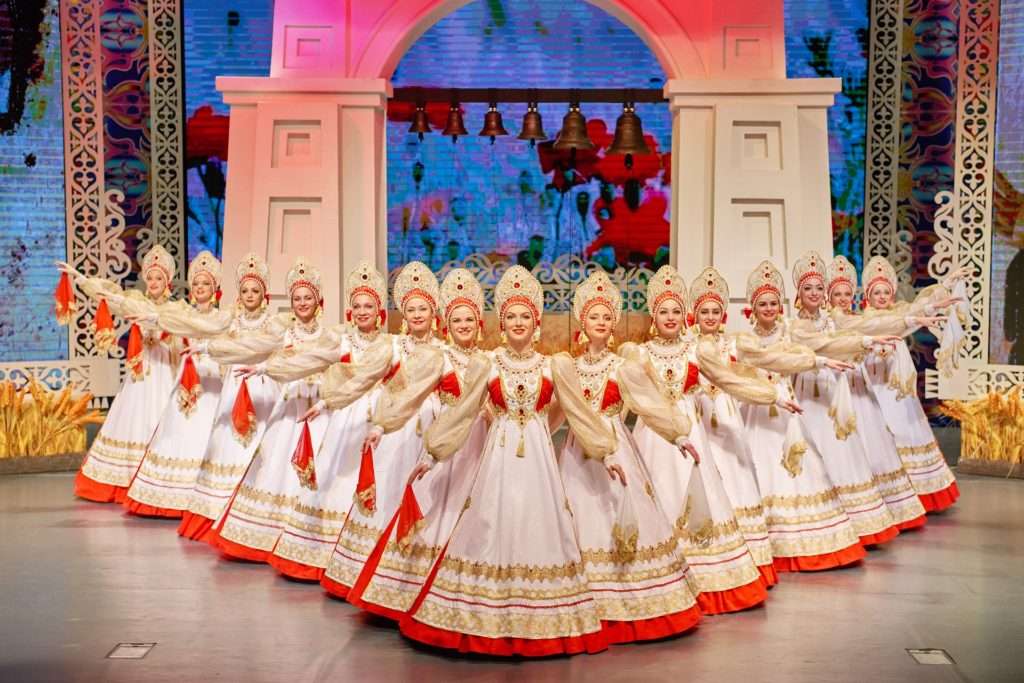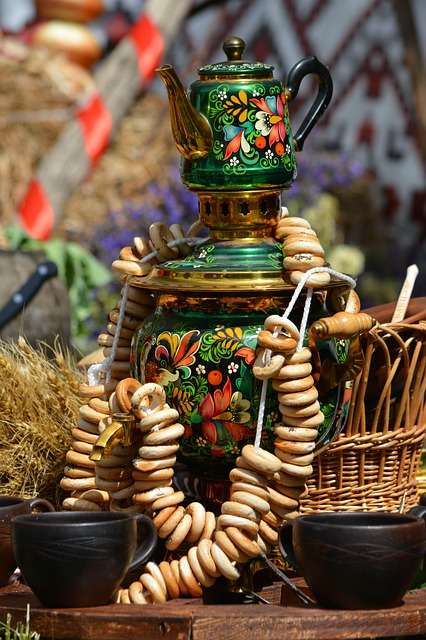
Arts| History | Music | Science | Customs | Traditions | Holidays
Russian Culture is comprised of many countries and nationalities due to the way the former Soviet Union grew and spread throughout eastern Europe. Many regions once considered part of the USSR were originally their own country with a separate language, territory, customs and traditions.
Generalized Russian culture is provided below to help you gain a better sense of the highlights and popular references you will find while traveling in Russia or when having a conversation about Russian Culture.
The Russian language is also a deeply rich part of the culture. For those interested in learning Russian, the best method is to consider attendance at a Language school in Moscow where a student can get maximum exposure and immersion in speaking, reading and understanding Russian.
New: The Russian National Anthem in English and Russian!
History
Russian Culture stems from dynamic influences and times spanning back as far as 862AD. It is commonly theorized a group of Scandavians known as Varagians crossed the Baltic led by a legendary warrior named Rurik. Perhaps the name “Russia” stemmed from this leaders name.
At this time the area known as Russia today was largely unsettled with small villages throughout the region. Rurik led his group to Novgorod and conquered the city, then became ruler. His descendants continued to rule and expand the kingdom as far south as the Black Sea, the Caucasus Mountains, and the lower reaches of the Volga River by 989AD.
Vladmir I was the ruler who selected Greek Orthodoxy (which later became Russian Orthodox) as the national religion. Russian villages were elevated to towns and cities based on the number of churches in their area. This is why it’s common to see so many chapels and cathedrals in such close proximity. While communism outlawed religion, it is obvious that Russians were always a religious people. Unfortunately many churches were destroyed during the Soviet time, but many remaining buildings are being restored today to preserve their religious and historical significance.
As villages grew into towns and cities, a border or Kreml (known in the east as a Kremlin) was built around their core parts of the town. This wall served as protection to the inhabitants and elevated the status of the town to a more established namesake. Many cities have preserved their Kremls as tourism and historical sites. A typical Kreml contains several Chapels or cathedrals, an armory, places to defend the walls, common village effects for livestock and everyday living for the time period. Some government offices are also located inside Kremls to show the significance of current governments active in the traditional hearts of their towns.
Art
Throughout history Russia has given birth to amazing and gifted artists. From Ballet and Literature to Paintings and architecture, the achievements and contributions of Russia is forever a part of the world canvas in the Arts.
Mikhail Glinka was the first Russian composer to create noteworthy Russian music. Prior to him, Russian music was dominated by foreigners. Glinka was influenced by Russian folk songs, Haydn, and Mozart. His major work is Kamarinskaya. Alexander Dargomizhsky was the next important Russian composer. He was influenced by Glinka and is remembered for his opera The Stone Guest. In this opera, he used continuous recitative, no key signatures, unusual modulations, and radical harmonies.
The Russian Five, Mily Balakirev, Cesar Cui, Modest Musorgsky, Nikolai Rimsky-Korsakov, and Alexander Borodin are a famous group of composers who worked in the 1800’s. These composers did not think of themselves as a group, but they did all follow the same basic principles in their music. They composed Russian nationalistic pieces by using religious and folk music as the basis for art music. They wanted freedom from strict forms in composition, advocated realism, and favored Romanticism. Tchaikovsky is another famous composer. Some of his most famous works are Swan Lake (1877), Sleeping Beauty (1890), and The Nutcracker (1892). Tchaikovsky was influenced by Russian folk songs and by Russian salon songs.
Russian music has continued to grow and modernize with numerous artists in the pop and folks music categories. Artists like Valeria, Smash and Avaria are as popular in Eastern Europe as any American band in the US. Even MTV has a Russian channel along with MuzTV which are tremendously popular.
Food

While Russia is famous for Caviar and Vodka, there is much more to the Russian palette than these exotic items. Much of the typical Russian meal resembles an American meal as served in the southern United States. Salad, Vegetables, Meats and fish, and of course a glass of wine is also common. To gain insight into the delicacies and customary dishes, take a look at RussianFoods.com
Science
Russian scientific achievements are well known throughout history. Most commonly familiar is the Russian space program which put the first satellite into space, the first man and first woman into space as well. Currently the International space.

First man in space April 12, 1961
Russian science and technological achievements are well known. On the top of the list there are: the invention of radio by A. Popov, the creation of the Periodical table of elements by D. Mendeleev, formulation of the principals of the interplanetary space flights on multistage rockets by K. Tsiolkovskiy, achievements of Russian space program lead by S. Korolev that include first unmanned space flight of “Sputnik” and first manned space flight of Yuri Gagarin, invention of laser by N. Basov and Yu. Prokhorov as well and many other discoveries.
There are around 4000 organizations in Russia involved in research and development with almost one million personnel. Half of those people are doing scientific research. It is coordinated by Ministry of industry, science and technologies, where strategy and basic priorities of research and development are being formulated.
Fundamental scientific research is concentrated in Russian Academy of Sciences, which now includes hundreds of institutes specializing in all major scientific disciplines such as mathematics, physics, chemistry, biology, astronomy, Earth sciences etc.
The applied science and technology is mainly done in Institutions and Design Bureaus belonging to different Russian Ministers. They are involved in research and development in nuclear energy (Ministry of atomic energy), space exploration (Russian aviation and space agency), defense (Ministry of defense), telecommunications (Ministry of communications) and so on.
#Russian_Traditions
Russian customs are plentiful in all parts and times of life. From birth until death there are highlights to be celebrated in each life.
The Samovar Tradition
Since the 17th century, when the custom of drinking tea migrated to Russia from China, Russians have taken the tradition of enjoying tea to heart, focusing on the samovar.A samovar is a large metal urn that heats water with burning charcoal or wood, or, more recently, electricity. On top rests a teapot in which a strong tea is brewed. Each cup is served by diluting this concentrate with hot water from the samovar’s spigot, then sweetening it with honey, sugar or jam.
Supremely functional and almost ubiquitous (in homes, offices and restaurants, aboard trains, even on street corners), samovars are beloved works of art. A samovar in the center of the table symbolizes home, comfort and good times. Families traditionally gathered around their tables on Sunday afternoons to share strong tea, a meal and news of their week.
Banya
The Russian banya (steam bath)tradition A popular tradition in the Russian culture is the bathhouse or banya. It involves steam, high heat, cold, and an invigorating beating with birch leaves and branches. The locations of the original type banyas are not easily found by foreigners, but placing a visit to a banya on your itinerary is highly recommended.
Many business negotiations in Russia take place in the relaxed atmosphere of the banya. It is a time honored activity and the love that the Russian people have for the banya is well documented.

The banya has not decreased in popularity today for many reasons. Traditionally, the banya was the common way for Russian villagers to cleanse the body, but the banya is also thought to have a powerful physiological effect on the entire organism. Researchers have found that the blood supply to the skin, muscles, and joints are notably improved after a visit to the banya. The body’s metabolism is increased considerably, the number of red blood cells and quantity of hemoglobin increases, the overall oxygen level increases and impurities are purged. The banya assists in eliminating toxins from the body and improves circulation of the blood.
The word banya derives from Latin balneum, which means “to chase out pain”. The benefits of banyas and saunas were the subject of ancient philosophers such as Aristotle and Hypocrites.
There are two major types of traditional banyas: The Russian Banya and the Roman Banya. Today many variations of both can be found. In the Roman Banya, the air is hot and dry, while in a Russian Banya hot and moist conditions are found.
The Russian steam banya normally reaches 80 to 100% humidity. The banya is not recommended for those that suffer cardiovascular diseases, hypertension, pulmonary tuberculosis or diseases of the skin or other transmittable diseases.
Russian banyas are gaining popularity in many parts of the world. Many manufacturers of personal home units offer many different styles to choose from that are centered around the traditional banya.
The use of certain herbs in the water of the banya is thought to magnify the effect of the banya experience. Many believe that the banya is particularly important for preventive maintenance of the health and balance of the body. Popular herbs used in the banya may consist of any combination of the leaves of the Eucalyptus Coltsfoots or Pine buds

The basic procedure in using the banya is centuries old. Visitors are cautioned to remember that bodily response to the banya and time in the steam and the cold is different for each individual.
Prior to a visit to the Banya, it is necessary to wash by warm water. However, dry hair is thought to protect the head from the heat. A recommendation for someone new to the banya experience to keep the head from overheating is to wear a woolen cap on the head, and prior to each banya session, wet this cap with cold water.
It is, of course, necessary to gradually get used to the heat of the banya upon entering. Several minutes are necessary to become acclimated and, initially, the banya patron should remain standing. Banya temperatures are not constant and may vary by as much as fifteen degrees so care should be taken at all stages. After becoming acclimated, the patron may sit or lie down allowing the muscles and the mind to become relaxed.
An integral part of the Russian banya is the birch broom. The leaves of the birch branch add to the experience and, used properly, provide the perfect massage to compliment the effects of the humidity of the banya.
For those new to the banya, the time in the banya should not exceed five to ten minutes. After the heat phase, many take an icy cold shower or immerse themselves in an icy water bath but not placing the head under the cold water. In winter, many hardy banya veterans will leave the banya and immerse themselves in a snow bank
Especially for newcomers to the banya, it is important to enter the banya or increase the heat and steam gradually. In some banyas, finding a higher seat will allow increasing the heat and steam and a lower seat for somewhat cooler temperatures. Equally important is leaving the heat and steam of the banya gradually. It is best to not hurry to have a cold shower or immerse in cold water and the showers of the newcomers could be limited to room temperature. The newcomer may wish to gradually reduce the temperature of the water in the shower. Similarly, it is best to not drink extremely cold water. To many hardy banya veterans, the gradual temperature change is not necessary.

The cold water provides a desired contrast with the temperature of the steam and produces a quenching effect. Some time relaxing in a waiting room wrapped in a sheet after a cool or cold shower is recommended. Many choose to repeat the steam heat / birching / cooling experience several times and re-enter the banya after about a fifteen minute rest period.
Participating in this uniquely Russian tradition will be an unforgettable part of your introduction to the Russian culture.
LIGHT STEAM TO YOU!* S LYOHKIM PAROM!


